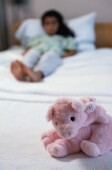
TUESDAY, Sept. 1, 2015 (HealthDay News) — When a child has cancer that resists standard therapies, the outlook can be grim. But a new study suggests that for some children, extensive genetic analysis can open up options.
The study found that among children with rare or aggressive cancers, genetic sequencing revealed potentially “actionable findings” in almost half of them. For some, that meant a change in diagnosis; for others, an inherited gene mutation was found, which allowed other family members to be tested.
And for 10 percent of the children, doctors were able to start therapy with a newer, “targeted” cancer drug that either temporarily beat the cancer back, or brought a complete remission.
On the surface, those numbers might not seem very encouraging, said lead researcher Dr. Rajen Mody, a pediatric oncologist at the University of Michigan C.S. Mott Children’s Hospital, in Ann Arbor.
“But these are the hardest of the hard cases. They’ve gone through all the tests and the treatments we have,” said Mody. “These are the children for whom we haven’t seen any real improvement in outcomes in the past 40 years.
“This offers some hope that we’ll be able to treat these children in a more personalized way,” he said.
In this case, “personalized” means zeroing in on the genetic mutations that make a child’s cancer unique, and then, if possible, targeting it with a drug — either an approved medication or one being tested in a clinical trials.
In the past several decades, huge strides have been made in treating childhood cancer. The most common childhood cancer, acute lymphoblastic leukemia, illustrates that point: In the 1960s, less than 10 percent of children survived the disease, according to the U.S. National Cancer Institute. Today, 90 percent do.
But that success has sometimes overshadowed the fact that other childhood cancers — such as some subtypes of leukemia, and certain tumors in the brain and nervous system — have resisted everything doctors throw at them. And when a child’s cancer recurs after initially responding to treatment, the odds of successfully battling back the disease vary, but are often low, according to background information in the study.
“A lot of people look at childhood cancer as a solved problem, but that’s not the case,” said Dr. John Maris, a pediatric oncologist at the Children’s Hospital of Philadelphia.
Maris co-wrote an editorial being published with the study in the Sept. 1 Journal of the American Medical Association.
According to Maris, the findings are important because they show that genetic sequencing has the potential to help children with cancer that relapses or fails to respond to treatment at all.
“But we still have a long way to go,” Maris said. Probably the biggest obstacle is that newer drugs often can’t be used for children because there is no data on their safety and effectiveness for kids — and there are no pediatric clinical trials underway.
The current findings are based on 91 pediatric cancer patients at Mott Children’s Hospital who were out of standard treatment options. Mody’s team analyzed each child’s genetic blueprint, or genome — including DNA and RNA from their tumors and healthy tissue.
It was an undertaking that typically required about 50 days and $6,000 for each child (though the study covered families’ costs), the study said.
In the end, Mody’s team found, 46 percent of the children had a genetic finding that could potentially be acted upon. Doctors were able to take that action for only some kids, though — including 14 children who started a new therapy, the study reported.
Those children were placed on recently developed, “targeted” cancer drugs — which zero in on specific mutations in a patient’s cancer cells. Overall, nine of the children responded, with either a partial or complete remission, the researchers found.
Mody agreed that the lack of targeted drugs available for children is a huge hurdle. The fact that a drug is approved or under study for adults does not mean it’s suitable for children, especially young children.
“A drug may only be available in a big pill that a little 2-year-old can’t take,” Mody said.
“What we need,” he said, “are more clinical trials with pediatric populations.”
One of the issues with that, Maris said, is that drug companies tend to be “risk-averse” when it comes to studying children. “There’s a fear of the drugs being more toxic in children,” he said.
But, Maris added, many families of children with incurable cancer would be willing to take that chance.
Other pediatric cancer centers are doing similar genetic sequencing, according to Maris. And it’s thought that with time, the costs and the turnaround time for results will decline.
What’s needed, Maris said, is a revamped system for developing and delivering new drugs to children with cancer.
More information
The American Cancer Society has more on childhood cancers.
Copyright © 2025 HealthDay. All rights reserved.

